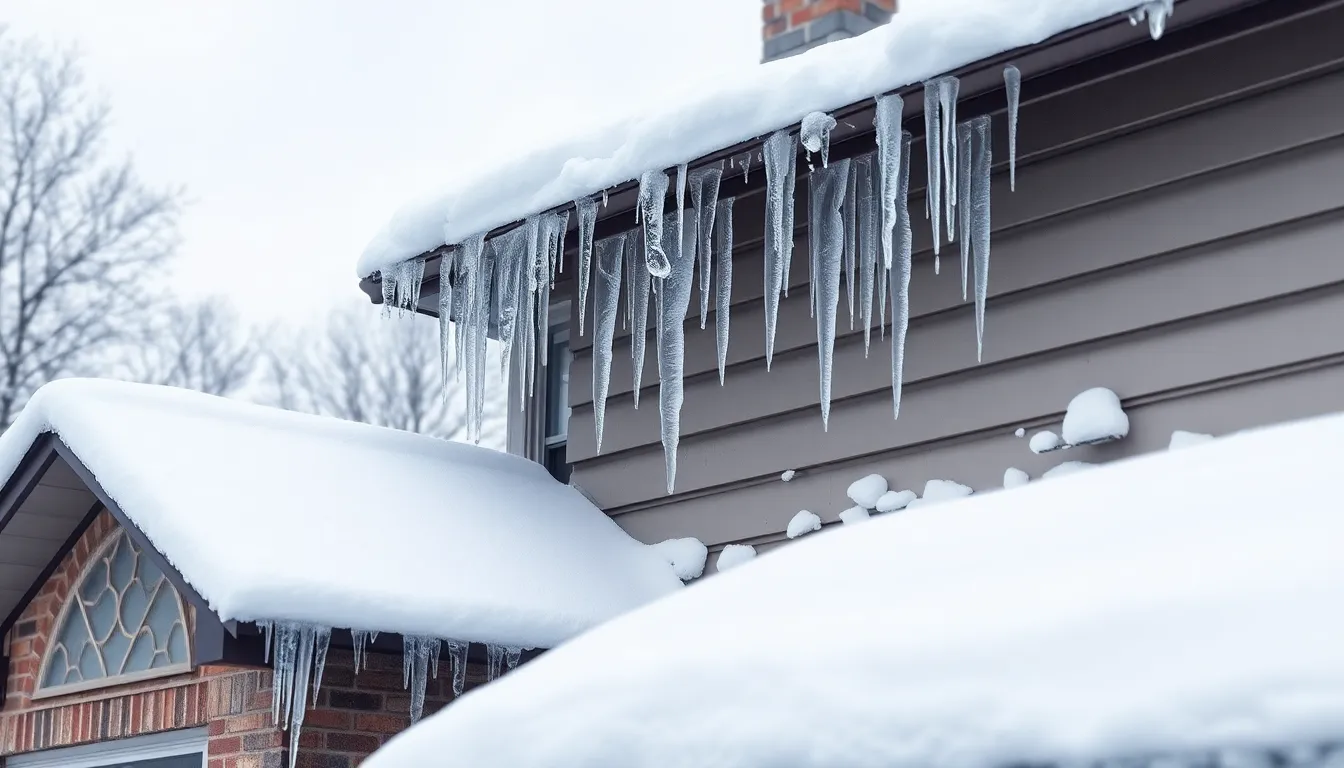Winter can be a beautiful season, but it also brings challenges like ice dams. These pesky formations occur when melting snow refreezes at the eaves of roofs, causing water to pool and potentially leading to leaks and structural damage. Homeowners need to understand the importance of ice dam removal to protect their properties and maintain their home’s integrity.
Ignoring ice dams can lead to costly repairs and mold issues. It’s crucial to act quickly and safely to address these problems. This article explores effective methods for ice dam removal, offering practical tips and strategies to tackle this winter nuisance. With the right approach, homeowners can safeguard their roofs and enjoy the beauty of winter without the worry of ice dam damage.
Table of Contents
ToggleOverview of Ice Dams
Ice dams are solid formations of ice that occur at the edges of roofs during winter. They develop when warm air from the attic melts snow on the roof, causing water to flow down. Once this water reaches the colder eaves, it refreezes, creating a barrier. The presence of ice dams can lead to significant problems, including water leakage, mold growth, and structural damage.
Proper understanding of ice dams involves recognizing their causes. Factors such as poor attic insulation and inadequate ventilation contribute to the formation of ice dams. When heat escapes through the roof, it accelerates the melting process, making it easier for water to freeze at the edges.
Homeowners should also be aware of the potential consequences of untreated ice dams. Water can back up under shingles, resulting in leaks that may damage ceilings, walls, and insulation. This type of damage often requires expensive repairs and can compromise indoor air quality due to mold growth.
Ice dams pose real threats to the integrity of a home and require prompt action. Knowledge of their formation, causes, and effects empowers homeowners to take preventive measures and maintain the health of their roofs throughout winter.
Causes of Ice Dams

Ice dams form due to a combination of weather conditions and structural issues. Understanding these causes can help homeowners take preventive measures.
Weather Factors
Snow accumulation on roofs leads to melting when warm air penetrates from the attic. Factors such as increased temperatures during the day and freezing temperatures at night create conditions ripe for ice dam formation. Heavy snowfall combined with fluctuating temperatures accelerates the melting process, allowing water to run down the roof and refreezing at colder eaves. According to the National Oceanic and Atmospheric Administration (NOAA), average snowfall in the U.S. can vary from 23 inches in the South to over 200 inches in the Northeast, impacting ice dam risk.
Roof Design Issues
Roof design significantly influences ice dam formation. Roofs with low slopes, improper overhangs, or inadequate insulation contribute to trapped heat. Insufficient ventilation in the attic exacerbates these issues, allowing warm air to circulate and melt snow. Structural components like skylights and chimneys can create temperature differentials on roofs, leading to uneven melting. The American Society of Home Inspectors quantifies roof pitch variations, noting that roofs with less than a 4:12 slope are more prone to ice dam complications.
Importance of Ice Dam Removal
Timely ice dam removal plays a crucial role in maintaining roof integrity and preventing issues related to water damage. Addressing ice dams promptly safeguards the home against potential hazards and costly repairs.
Property Damage Prevention
Effective ice dam removal mitigates the risk of water leakage that can lead to interior damage. Water seeping through roofs caused by ice dam buildup can result in unsightly stains, mold growth, and deterioration of structural materials. Regular inspections and proactive removal of ice can preserve the durability of roofing materials. According to the Insurance Institute for Business & Home Safety, untreated ice dams can cost homeowners thousands in repairs, making prevention essential.
Safety Hazards
Ice dams pose significant safety hazards, particularly when ice and snow fall from roofs. Falling ice can cause injuries to individuals passing by or damage to vehicles and outdoor structures. Furthermore, ladders used for ice dam removal present their own hazards if not secured properly. Removing ice dams carefully decreases the likelihood of injury and property damage. Statistics from the National Safety Council indicate that falls from ladders lead to over 160,000 injuries annually, underscoring the need for cautious ice removal practices.
Methods of Ice Dam Removal
Effective ice dam removal techniques help prevent damage and preserve the integrity of roofs. Homeowners can choose between manual removal and professional services based on their needs and safety considerations.
Manual Removal Techniques
Manual removal techniques involve several practical methods.
- Rooftop Shoveling: Use a roof rake with a telescoping handle to gently pull snow off the roof. Start at the edge and work upwards to ensure safety and minimize snow weight.
- Ice Melting Products: Apply calcium chloride or similar ice-melting agents by placing them in a sock or pantyhose. This method promotes melting without damaging roofing material.
- Hot Water Application: Heat water to a warm temperature, but not boiling, and pour it along the ice dam’s edge. This technique helps melt ice effectively while being cautious of the potential for rapid refreezing.
- Heat Cables: Consider installing heat cables along the roof edge and in gutters before winter. This preventive measure reduces the likelihood of ice dam formation.
Professional Services
Professional services provide expertise and equipment for ice dam removal.
- Specialized Equipment: Professionals use infrared cameras to identify heat loss areas and prevent future ice dam formation. They often employ steamers or high-pressure water systems for safe and effective removal.
- Assessment and Repair: Professionals conduct thorough assessments of the roof and can address underlying insulation and ventilation issues, further mitigating ice dam risks.
- Safety Protocols: Professional services adhere to safety guidelines to minimize risks. They are trained in proper ladder use and worksite safety to protect both the property and individuals involved.
- Warranty and Guarantees: Many professional services offer warranties or guarantees for their work, providing peace of mind that issues will be addressed should they recur.
By considering these methods of ice dam removal, homeowners can choose the best approach to protect their roofs and ensure safety throughout the winter season.
Prevention Tips for Ice Dams
Proper preventive measures can significantly reduce the risk of ice dams forming on roofs. Homeowners can implement strategies to enhance insulation and maintain their roofs, safeguarding against potential damage.
Proper Insulation
Proper insulation in the attic prevents warm air from escaping and melting snow on the roof. Insulation materials, such as fiberglass or foam boards, should fill any gaps to ensure efficient thermal management. The recommended R-value for attic insulation varies by region, typically ranging from R-30 to R-60. Air sealing also plays a critical role; it eliminates drafts and helps maintain consistent temperatures within the attic. Homeowners can inspect for air leaks around ducts, electrical outlets, and light fixtures. By enhancing both insulation and sealing, homeowners minimize heat loss, thereby reducing the likelihood of ice dam formation.
Regular Roof Maintenance
Regular roof maintenance helps identify potential issues before they escalate. Homeowners should perform seasonal inspections, looking for damaged shingles, clogged gutters, or any debris on the roof. Clear gutters and downspouts to facilitate proper water drainage; standing water can freeze and contribute to ice dam formation. Trimming overhanging branches prevents snow accumulation on roofs. For roofs with a history of ice dams, installing heat cables along the eaves provides an additional layer of protection, preventing ice buildup. By prioritizing maintenance, homeowners enable their roofs to withstand winter conditions effectively.
Addressing ice dams promptly is crucial for maintaining a healthy roof and avoiding costly repairs. By understanding the causes and implementing effective removal techniques, homeowners can protect their properties from potential damage. Regular inspections and proper insulation play a vital role in prevention, ensuring roofs withstand winter’s challenges.
Whether opting for DIY methods or professional services, prioritizing safety during removal is essential. With the right approach, homeowners can enjoy a worry-free winter season while safeguarding their homes from the risks associated with ice dams. Taking these proactive steps not only preserves the integrity of the roof but also enhances overall home safety and comfort.







